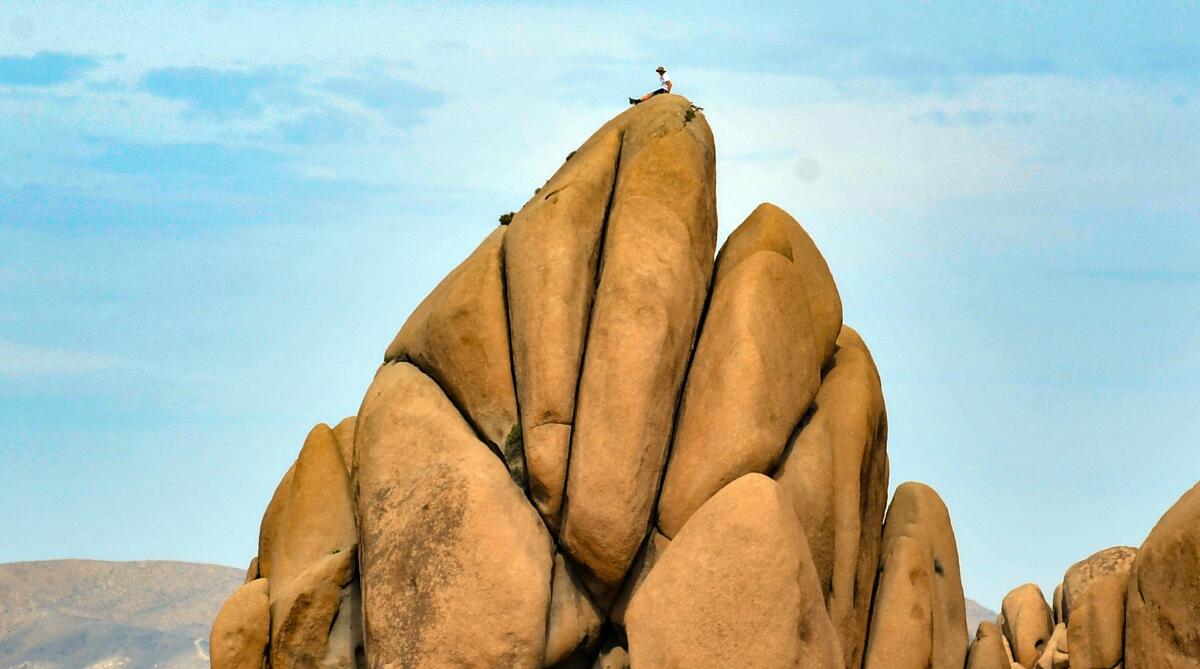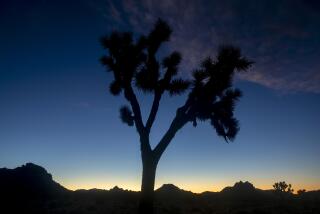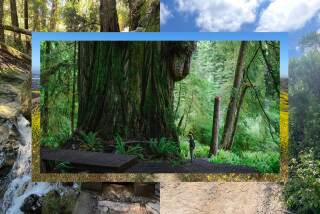National parks: Aggressive bees close a second Joshua Tree campground

- Share via
Rangers at Joshua Tree National Park , who five days ago shut down the popular Jumbo Rocks Campground “due to aggressive honey bee activity,” have now shut down the Cottonwood Visitor Center and Cottonwood Campground for the same reason.
The bees are thirsty, park spokeswoman Hannah Schwalbe said, and rangers are taking this time “to figure out how to disperse the bees or just give them time to find other water sources.”
The Cottonwood area is about 30 miles south of Jumbo Rocks.
When the bee situation arose last week, “there were a couple of vehicles with a lot of bees in them. And campsites. Visitors were very uncomfortable,” said Joshua Tree Superintendent David Smith at the time. He said no stings were reported, the bees are “standard honey bees” and the park’s many other campgrounds remain open.
Despite frequent temperatures over 100 degrees, Joshua Tree has remained relatively busy in recent weeks. NPS statistics show 184,139 visitors to the park in June. That’s a decline of less than 2% from 2019 in a year that has seen the rest of the park system and travel industry turned sideways.
Meanwhile, 300 miles to the northwest on the Sierra slopes of Sequoia National Park, biologists have spotted California condors for the first time in decades.
Summer has brought these and other wonders to California’s nine national parks, which are gradually reopening after shutting down in March. Though Gov. Gavin Newsom continues to urge that Californians postpone leisure travel until the pandemic eases, Yosemite, Sequoia, Kings Canyon and a few other parks have opened some lodgings and camping areas.
Here’s a roundup:
•At Joshua Tree, six campgrounds, including Indian Cove, are open, as are its Joshua Tree and Oasis of Mara visitor centers and the Black Rock Nature Center. But because of the bees, Jumbo Rocks will be closed through July 23.
The bee situation is unusual, but not completely surprising, Smith said. In fact, scientists have estimated that there are hundreds of bee species in the park and a swarm forced temporary closure of the park’s Keys View overlook a year ago.
But the closure does put about 180 campsites out of commission. (Through Sept. 4, all camping in the park is first come, first served.)
Smith said the bees “are a natural part of the California desert, and they play a crucial role in helping the plant communities to pollinate... They’re also very thirsty creatures.”
When thirsty bees don’t find their way to water sources in the park like Barker Dam and Keys Ranch, Smith said, they go looking for moisture at picnic tables and on the air-conditioning condensers of cars and RVs. Smith said he was “a little surprised” to see so many bees at Jumbo Rocks, given the many other options.
•In Sequoia National Park, NPS staffers and visiting biologists in late May spotted two California condors near Moro Rock and four more in the Giant Forest, the National Park Service and the U.S. Fish and Wildlife Service said Tuesday.
The species was declared endangered in the late 1960s and dwindled to just a few dozen remaining birds, but more were bred in captivity and gradually reintroduced to the wild beginning in the 1990s.
In Sequoia and its sibling park Kings Canyon, an increasing number of roads, trails, restrooms and picnic areas are open. On July 6, rangers opened Potwisha Campground and Lodgepole Campground in Sequoia and Sunset Campground in Kings Canyon (reservations required through recreation.gov).
Other campgrounds in the parks remain closed for now, and all previous 2020 camping reservations in the two parks have been canceled as part of pandemic closures and restrictions. The Wuksachi Lodge is open, as are Grant Grove and Lodgepole markets and horseback rides at Cedar Grove Pack Station and Grant Grove Stables in Kings Canyon National Park.
At other California parks:
•In Yosemite National Park, only day-trip visitors with advance reservations are allowed in, and the park is capped at 1,700 day-tripping vehicles per day. Though the park’s lodgings are open at limited capacity, the only campground open in Yosemite Valley is Upper Pines, at half-capacity: 120 campsites.
Rangers have said the campground situation will remain this way through at least the end of July, which means little or no availability through the park’s camping booking site, recreation.gov.
•Channel Islands National Park. This park never officially closed, but once concessionaire Island Packers stopped running daily boats, visitor traffic dried up. On June 1, Island Packers resumed running boats to the islands but at reduced capacity to give passengers more room. The Santa Barbara Adventure Co. has resumed kayak tours on Santa Cruz Island.
Get The Wild newsletter.
The essential weekly guide to enjoying the outdoors in Southern California. Insider tips on the best of our beaches, trails, parks, deserts, forests and mountains.
You may occasionally receive promotional content from the Los Angeles Times.
•Death Valley National Park. The park has partially reopened — it was the last of the California national parks to do so — just in time for summer temperatures sometimes surpassing 110 degrees. In late June, park officials announced the reopening of most park roads, trailheads, restrooms and overlooks, along with its Furnace Creek, Emigrant, Mesquite Flat, Saline, Eureka, Homestake, Wildrose, Thorndike and Mahogany campgrounds. The Oasis at Death Valley, a privately owned complex of hotel rooms, restaurants and shops that serves as the park’s principal commercial hub, opened June 18. The Furnace Creek Visitor Center and Stovepipe Wells Ranger Station remain closed. Because of the heat, rangers urge visitors not to hike at lower elevations after 10 a.m.
•Golden Gate National Recreation Area. The area’s popular Muir Woods site opened in late June, with mandated advance parking reservations. Still closed: Alcatraz, the Golden Gate Bridge Welcome Center, Point Bonita Lighthouse and all campgrounds and picnic sites, along with visitor centers at the Presidio and Lands End. Now open: Conzelman Road (famed for its view of the Golden Gate Bridge), parking at Stinson, Muir and Rodeo beaches, parking at Tennessee Valley, Fort Baker and Horseshoe Cove.
•Lassen Volcanic National Park. Hiking trails have reopened (except Bumpass Hell, which remains closed because of snow hazards), as have the park’s 30-mile highway and Butte Lake and Warner Valley roads. Permitted backcountry camping has resumed too. Walk-in campgrounds at Manzanita Lake and Southwest have opened. Seasonal campgrounds will open on previously scheduled dates; check Lassen’s website. The visitor center and museum remain closed.
•Redwood National and State Parks. Trailheads and parking lots have reopened, as well as restrooms, though guests are advised to bring soap and hand sanitizer. Visitor centers and campgrounds remain closed.
•Pinnacles National Park. The western entrance near Soledad is open from 8 a.m. to 8 p.m. The eastern entrance near Paicines is open but with limited parking. Visitors should arrive before 11 a.m. or after 3:30 p.m to get a spot. The campground on the eastern side remains open; visitor centers are still closed.
•Santa Monica Mountains National Recreation Area. The area, which straddles Los Angeles and Ventura counties, has reopened most of its trails, parking lots, overlooks and restrooms. Its two visitor centers remain closed, as are some areas damaged by the Woolsey fire in 2018.
More to Read
Sign up for The Wild
We’ll help you find the best places to hike, bike and run, as well as the perfect silent spots for meditation and yoga.
You may occasionally receive promotional content from the Los Angeles Times.







